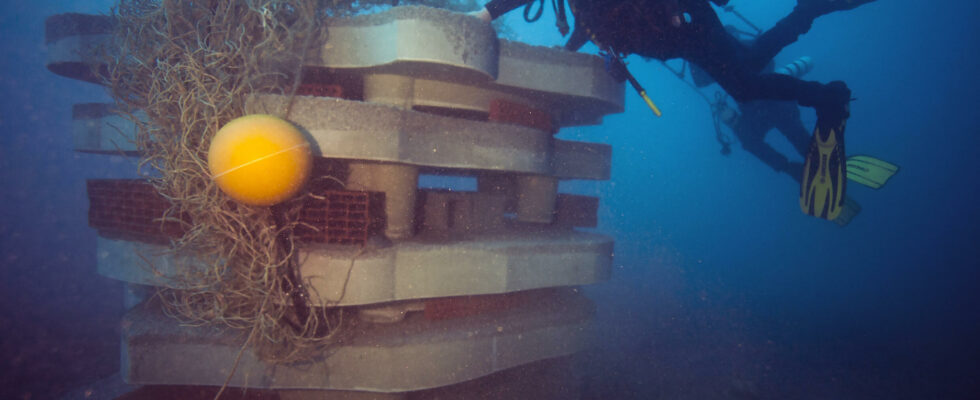At least 160 underwater species have returned to settle in the Cortiou cove, in Marseille, thanks to artificial reefs. The ecosystem has been seriously degraded since the 19th century by polluting discharges. However, the relevance of such a device is debated.
From our correspondent in Marseille,
Sea urchins, crustaceans, sponges, bryozoans… and a farandole of fish! At least 160 underwater species have found refuge in the 36 submerged artificial reefs of the Cortiou cove in Marseille, according to theWater agency – Rhône, Mediterranean, Corsica. “ Underwater life has been greatly disrupted. We wanted to see if life could resume, and these results are very encouraging! », welcomes Annick Mièvre, regional director Provence-Alpes-Côte d’Azur and Corsica of this agency.
Because since the 19th century, Cortiou has served as an outlet for wastewater from Marseille and the influx of polluting discharges severely disrupts the ecosystem of the cove. In 1987, a treatment plant was built to treat wastewater before sending it to the cove: the lesser evil for Cortiou. But improving water quality is not enough to bring back marine populations.
“ Biomass does not mean ecological quality »
Suggested in particular by the Calanques National Park, the Rexcor project was launched in 2017. “ The idea was to give a boost to marine life that had not returned on its own,” explains Annick Mièvre. Four “fish villages”, made up of several reefs each, are submerged between 10 and 25 meters deep. The closest site is located 200 meters from the polluting discharge point, two others 700 meters away and the last one 1.5 kilometers away. “ This makes it possible to study the return of marine life depending on the proximity to the point of pollution. », explains Sandrine Ruitton, researcher at the Mediterranean Institute of Oceanology. The reefs must last at least 30 years and withstand a 9 meter swell.
Seven years later, all the sites are colonized: “ It was deduced that life could resume, even in the vicinity of rejection. », remarks Annick Mièvre from the Water Agency. Which, according to her, could give rise to other projects of this type around such degraded places.
“ Attentionweighs Sandrine Ruitton, the presence of biomass [matière organique végétale ou animale, NDLR] does not mean ecological quality! There are species which proliferate, which are invasive, but there may also be the presence of large predators, such as conger eels. » The researcher dives every season to observe the population of the reefs and recalls that “ any submerged structure is automatically colonized, because it represents a habitat for species that will find food there, even in polluted areas “. Certain species such as groupers and wrasses, which are more sensitive, have not returned to the vicinity of the polluting discharge.
Also read Oceans Day: the corals have not said their last word
Waters still polluted
Certainly, the water discharged now meets environmental standards, but it remains dirty. “ In addition, it is fresh water: we therefore have a local modification of the salinity of the water, which leads to changes in the environment. », analyzes Sandrine Ruitton. For her, “ we cannot talk about ecological restoration “, because it would have been necessary to stop the pressure responsible for the degradation of the ecosystem. But in this case, “ the source of pollution is not stopped. »
Given the still degraded state of the area, the scientist questions the relevance of such an experiment. Especially since during stormy episodes, the treatment plant saturates and opens the valves without treating the wastewater and sometimes allowing macro-waste to pass through. So plastic cans and bottles end up at the bottom of Cortiou.
At 1.4 million euros, the scientist questions the relevance of the project “ which does not preserve the environment » as awareness-raising or protection actions could have done. “ We must not lose sight of the fact that reefs artificialize the environment. This is not optimal when we want to restore an ecosystem », she adds. 300 tonnes of concrete were deposited at the bottom of Cortiou.
To listen in C’est pas du vent When children become ambassadors for the coral reefs of the Indian Ocean
